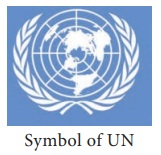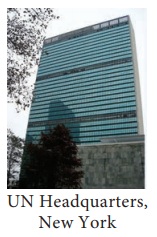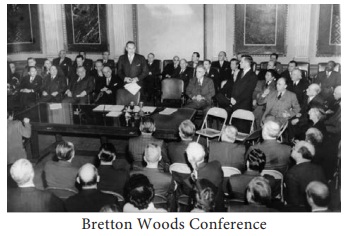World War II - New International Order | 10th Social Science : History : Chapter 3 : World War II
Chapter: 10th Social Science : History : Chapter 3 : World War II
New International Order
New International Order
By 1941
the United States and Britain began to give serious consideration to the need
for international cooperation for achieving lasting peace among all nations.
International economic and financial stability were also important objectives.
All these would need international organizations with members of the various
nations across the world working together for these common objectives. This
ultimately resulted in the establishment of the United Nations, the World Bank
and the International Monetary Fund, with many associated organizations which
deal with basic issues of importance for all societies and countries.
United Nations
The first
initiative for the United Nations came from the United States and Britain in
1941 when they issued a joint declaration known as the Atlantic Charter. This
Declaration of the United Nations was accepted by all the 26 countries which
were fighting against the Axis powers (Germany, Italy and Japan) on New Year’s
Day, 1942.The Charter of the United Nations was signed on June 26, 1945 by 51
nations. India which was not an independent country then also was a signatory
to the Charter. Now the United Nations has 193 member states and each one - big
or small - has an equal vote in the United Nations.

"We, the peoples of the United Nations, determined to save
succeeding generations from scourge of war, which twice in our lifetime has
brought untold sorrow to mankind, and to reaffirm faith in fundamental human
rights, in the dignity and worth of the human person, in the equal rights of
men and women, and of nations large and small …”. - from The Preamble to the
United Nations
General Assembly and Security Council
The
United Nations functions almost like any government, through its principal
organs which are similar to the legislative, executive and judicial wings of a
state.

In the
General Assembly is the body in which each member state is represented. It
meets once a year and issues of interest and points of conflict are discussed
in the Assembly. The Security Council has fifteen members. Five countries - the
United States, Britain, France, Russia and China - are permanent members, and
there are ten temporary members who are elected in rotation. These two bodies
function like a legislature. Each of the permanent members has the right to
veto any decision by the other members of the Security Council. This right has
often been used to block major decisions, especially by the superpowers, the US
and Russia. Major issues and conflicts are discussed in the Security Council.
Administrative Structure
The
executive wing of the United Nations is the UN Secretariat. It is headed by the
Secretary General, who is elected by the General Assembly on the recommendation
of the Security Council. The Secretary General, along with his cabinet and
other officials, runs the United Nations. The International Court of Justice,
headquartered at The Hague in Holland, is the judicial wing of the United
Nations. The Economic and Social Council (ECOSOC), the fifth organ of the
United Nations, is responsible for coordinating all the economic and social
work of the United Nations. The regional Economic Commissions functioning for
regional development across the various regions of the world (Asia Pacific,
West Asia, Europe, Africa and Latin America) are organs of ECOSOC. They have
been very successful, and have been headed by eminent economists like Gunnar
Myrdal.
Other Important Organs of the UN
Associated
organizations deal with areas of critical interest to the world at large like
food, health and education, and culture. These are: Food and Agriculture
Organisation (FAO), World Health Organisation (WHO), UNESCO (UN Educational,
Scientific and Cultural Organisation). There are also special organizations
funded voluntarily by member countries. The two best known among them are
UNICEF (United Nations Children’s Fund) which promotes child health and welfare
across the world, and the UNDP (United Nations Development Programme), which
focuses on development.
Activities of the UN
Over the
decades, the United Nations has expanded its activities in response to the
changing problems facing the world. Thus, in the 1960s, decolonization was an
important issue. Human rights, the problems of refugees, climate change, gender
equality are all now within the ambit of the activities of the United Nations.
A special mention must be made of the UN Peacekeeping force, which has acted in
many areas of conflict all over the world. The Indian army has been an
important part of the peacekeeping force and has been deployed in many parts of
the world.
World Bank
The World
Bank and the International Monetary Fund, referred to as the “Bretton Woods
Twins”, were both established in 1945 after the Bretton Woods Conference in
1944. Located in Washington D.C. in the United States, they have the same
membership, since a country cannot be a member of the Bank without being a
member of the Fund.

The two
main organs of the World Bank are the International Bank for Reconstruction and
Development (IBRD) and the International Development Agency (IDA), Together
they are often referred to as the World Bank. The main responsibility of the
IBRD in the initial years was to fund the reconstruction activities under the
Marshall Plan in the European countries devastated by the war. The agenda later
expanded to promote economic development in poorer countries and the Bank lends
money to various countries for developmental projects. A further area of
interest is poverty alleviation, especially in the rural areas of developing
countries. The International Development Agency (IDA) also lends money to
governments for developmental activities. These loans are “soft” loans, and are
given at very low rates of interest for a period of 50 years. The International
Finance Corporation (IFC) mainly functions with private enterprises in
developing countries.
In recent
years the Bank is actively promoting the achievement of the Millennium
Development Goals which aim at improving living standards, removing illiteracy,
empowering women and improving maternal and child health, improving the
environment and eradicating AIDS.
International Monetary Fund (IMF)
The
International Monetary Fund was primarily the brainchild of Harry Dexter White
and John Maynard Keynes, the famous economist. It was formally organized in
1945 with 29 member countries. It now has a membership of 189 countries. Its
primary objective is to ensure financial stability and development across the
world. The main agenda is to promote international monetary cooperation,
expansion of international trade and exchange stability. The Fund lends money
from its resources to countries facing balance of payments problems (because
they are unable to pay for their imports). It however imposes stringent
conditions on the borrowing nations to tighten their budgets, practice fiscal
prudence and reduce their expenditure. This is often unpopular, especially among
the developing countries which may have to cut down on various programmes which
provide subsidies to the people.
The objectives of the IMF are: “to foster global monetary
cooperation, secure financial stability, facilitate international trade,
promote high employment and sustainable economic growth and reduce poverty
around the world.”
Related Topics